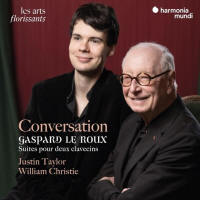Texte paru dans: / Appeared in:
|
|
|
|
|
|
Gaspard Le Roux is a relatively familiar presence among the French Baroque harpsichordist-composers, even if very little is known about his life. Though he was evidently esteemed in his day, today we do not even know where he came from, where he played or what his dates of birth and death were. His one book of Pièces de clavessin, published in Paris in 1705, contains seven suites of the usual dances, some preceded by semi-notated ‘unmeasured preludes’ of the type associated with Louis Couperin, and a fine recording of these melodically appealing and soundly constructed pieces was made by Christophe Rousset in 1993 (L’OiseauLyre, 7/95). Interest in Le Roux, however, has centred mainly on the fact that his publication not only included parallel versions for two treble instruments and continuo, but further recommended them for realisation on two harpsichords. It is in this enticing form that they have most often been recorded.
Le Roux did not make it entirely clear how these arrangements were to be done, so performers have to find their own way. William Christie and Justin Taylor have chosen to distinguish between the roles they take, and thus Taylor focuses mainly on the highly ornamented top line while Christie concentrates on turning the other parts into a sort of continuo (though scarcely a less melodic or busily ornate one). It works well, creating a bubbling whirl of trills and ports de voix, together yet exquisitely not quite together, while never losing the music’s strong sense of direction. The harpsichords – one French, one Flemish – combine beautifully, their sound melding as if into a single rich and supple super-harpsichord.
Christie was a ‘young artist’ when his first recording of some of these pieces with Arthur Haas was reviewed (Harmonia Mundi, 10/78), but now he finds himself duetting with a player nearly five decades his junior. Between them they make some wise decisions, not least in varying the texture: the sound of the two instruments in full ornamental flow is imposing – the Chaconne is a big beast, with rocket-scales firing off in the bass – so it makes sense not just to thin registrations here and there but also to dial down the trilling, as they do in some of the sarabandes and the pressingly tender ‘La Favorite’. This recording is not quite the complete Le Roux – a handful of pieces are missing and you will need to turn to other recordings to hear them – but the gain is in some wonderfully effective transcriptions of well-known works by distinguished contemporaries: Lully’s Marche pour la cérémonie des Turcs and Passacaille from Armide both pack an orchestral punch, while Marais’s noble viol piece Les voix humaines is a study in expressive intensity achieved through stillness, silence and canny insinuation of the lute stop. Altogether, a hugely enjoyable celebration of French harpsichord plushness. |
|




